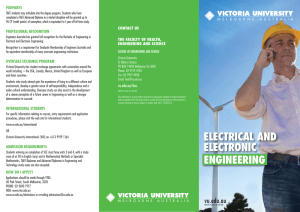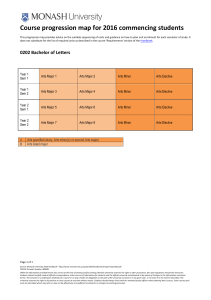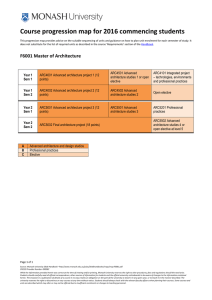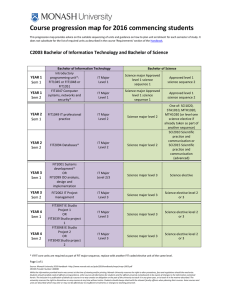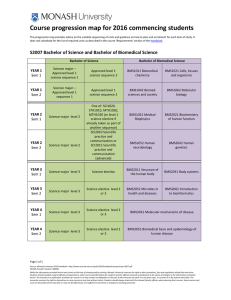electrical and electronic engineering
advertisement
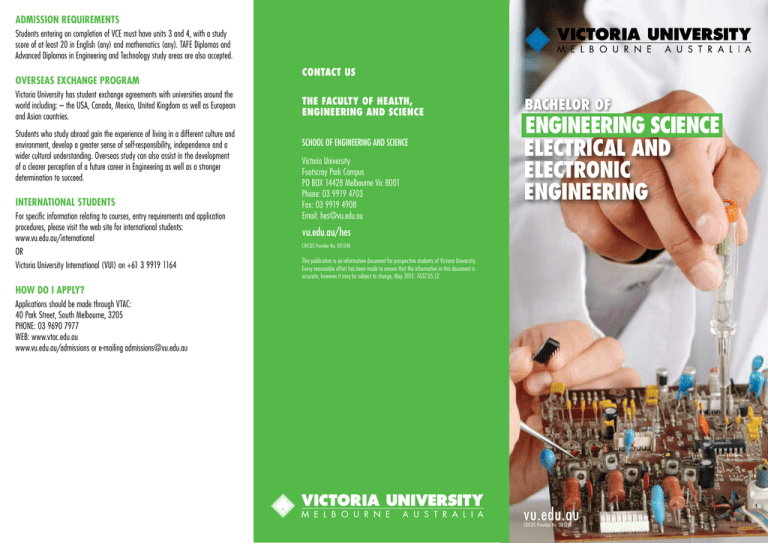
ADMISSION REQUIREMENTS Students entering on completion of VCE must have units 3 and 4, with a study score of at least 20 in English (any) and mathematics (any). TAFE Diplomas and Advanced Diplomas in Engineering and Technology study areas are also accepted. OVERSEAS EXCHANGE PROGRAM Victoria University has student exchange agreements with universities around the world including: – the USA, Canada, Mexico, United Kingdom as well as European and Asian countries. Students who study abroad gain the experience of living in a different culture and environment, develop a greater sense of self-responsibility, independence and a wider cultural understanding. Overseas study can also assist in the development of a clearer perception of a future career in Engineering as well as a stronger determination to succeed. INTERNATIONAL STUDENTS For specific information relating to courses, entry requirements and application procedures, please visit the web site for international students: www.vu.edu.au/international OR Victoria University International (VUI) on +61 3 9919 1164 contact us The Faculty of HEALTH, ENGINEERING AND SCIENCE SCHOOL OF ENGINEERING AND SCIENCE Victoria University Footscray Park Campus PO BOX 14428 Melbourne Vic 8001 Phone: 03 9919 4703 Fax: 03 9919 4908 Email: hes@vu.edu.au BACHELOR OF ENGINEERING SCIENCE ELECTRICAL AND ELECTRONIC ENGINEERING vu.edu.au/hes cricos Provider no. 00124K This publication is an information document for prospective students of Victoria University. Every reasonable effort has been made to ensure that the information in this document is accurate, however it may be subject to change, May 2012. 7637.05.12. HOW DO I APPLY? Applications should be made through VTAC: 40 Park Street, South Melbourne, 3205 PHONE: 03 9690 7977 WEB: www.vtac.edu.au www.vu.edu.au/admissions or e-mailing admissions@vu.edu.au vu.edu.au cricos Provider no. 00124K BACHELOR OF ENGINEERING SCIENCE IN ELECTRICAL AND ELECTRONIC ENGINEERING COURSE CODE: EBDT (3 YEAR COURSE) CRICOS NO: 057278J WHY CHOOSE VU? • VU works with major employers in Victoria; • VU is the only University in Victoria, which offers Problem Based Learning across the entire course; • Most of teaching staff have had extensive industrial experience, which adds aspects of practicality; • VU has one of the best teacher to student ratio in Australia; • Practical knowledge and ability to start work without additional training on the job is well regarded by the employers, giving another advantage to the graduates of VU when applying for jobs; • 25% of learning at VU is directed towards LiWC (Learning in the Workplace and Community). This makes knowledge and learning experience gained at VU very practical. Graduates are work ready and require less or no orientation training when starting new job. WHAT IS PBL? Problem Based Learning – students form teams of about five, and work together on real-life industry and community problems. This real-world learning begins right from first year, so you’re applying theory to practice all the way through your study, not in just your final years. With training like this, VU engineering graduates are not only technically skilled, but great team players with hands-on experience and excellent communication skills. WHAT IS AN ENGINEER? Electrical and Electronic Engineers: – • Are responsible for electricity generation and distribution • Design complex electronic equipment • Manage large industrial manufacturing plant • Research and develop new energy sources • Design and manage our Telecommunications infrastructure including telephones, radio, TV and the internet • Build efficient cars and planes • Create robots to increase manufacturing • Create new technology to make manufacturing cheaper and cleaner • Operate machines • The course is delivered using Problem Based Learning (PBL) methodology which uses real-world problems as a significant part of the learning process; • Graduates can find employment in a number of industries: 1. EMBEDDED SYSTEMS Design, test and build microprocessor based controllers for intelligent equipments and machines such as automobile engine management system, brake system, washing machine, remote data logger etc. 2. ELECTRONIC CIRCUIT BOARD DESIGN Simulate and test complex electronic circuit boards using latest CAD software prior to out sourced manufacturing. 3. FACTORY AUTOMATION Design, install, operate and maintain automatic control systems for factory production. 4. COMPUTER NETWORKING Plan, design, install, operate and maintain computer networks for home, office, school etc. 5. POWER ELECTRONICS Design and maintain power electronic systems for efficient operation of high power machinery. First year subjects in electrical, electronic, computing, mathematics and physics studies are designed to provide a firm foundation for a wide range of higher level subjects in later years of the course. In years two and three the students will be introduced to the tools, techniques and theories of Embedding Systems, Networking, Automation, Analog and Power Electronics. The course has a focus on practical applications. Design and project work forms a significant component of the total program. Students will apply the theories and techniques learned in the course to both team projects as well as an individual project in year 3 of the course. Student completing their studies at an appropriate standard may be granted up to two years credit into the Bachelor of Electrical and Electronic Engineering degree. In addition those completing Year 1 of the program will be able to transfer to Year 2 of the Bachelor of Engineering in Electrical and Electronic Engineering course. PATHWAYS TAFE students may articulate into the program. Students who have completed a TAFE Advanced Diploma in a related discipline will be granted up to 96 CP (credit points) of exemption; which is equivalent to 1 year of full time study. UNITS AND ELECTIVES BUSINESS/TECHNICAL ELECTIVE (12 CREDIT POINTS) Business/Technical electives can be chosen from The School of Engineering and Science or from other Faculties within the university with approval from the course co-ordinator. COURSE STRUCTURE YEAR 1 YEAR 2 WHY CHOOSE THIS COURSE? EMPLOYMENT OPPORTUNITIES An engineer can: • Create the next generation computers COURSE STRUCTURE YEAR 3 SEM 1 Engineering Mathematics 1 Engineering Physics 1 Engineering and the Community Problem Solving for Engineers SEM 2 Engineering Mathematics 2 Engineering Physics 2 Engineering Computing Introduction to Engineering Design SEM 1 Digital and Computer Systems Fundamentals of Electrical and Electronic Circuits Engineering Design and Practice 2a SEM 2 Electronic Systems Industrial Control and Automation Engineering Design and Practice 2b SEM 1 Analog and Optoelectronics Operating Systems and Network Programming Engineering Project 3a Elective SEM 2 Embedded and Networked Systems Power Electronics and Machines Engineering Project 3b Elective
